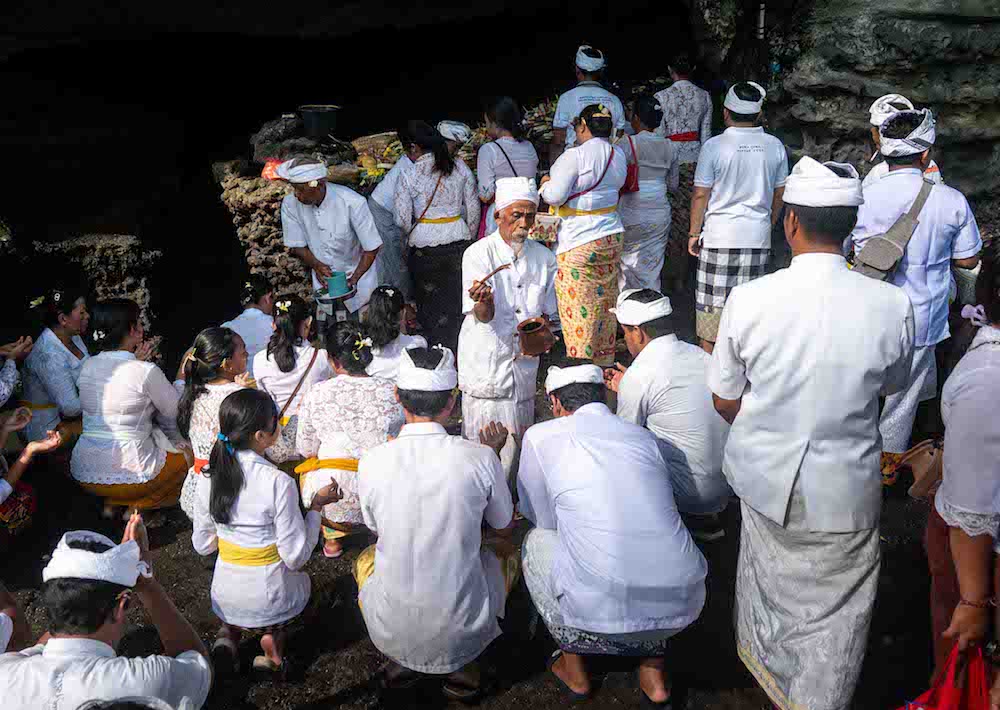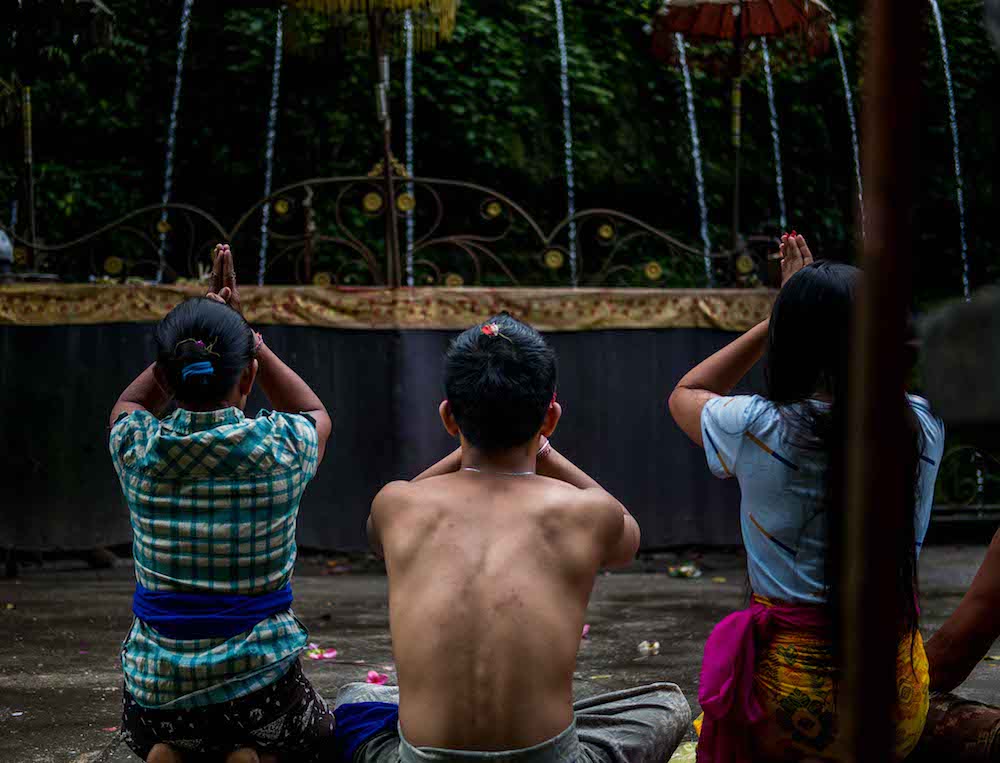Journalist Eric Buvelot and socio-ethnologist Jean Couteau have recorded 20 hours of discussion about changes that have happened in Bali since the 70’s. The conversation was structured and segmented according to many different aspects of Balinese life, mostly from a socio-historical perspective, to trace all the overturning in Balinese mores since 50 years, when modernity started to shape new behaviours.
At the core of these changes, the birth of individuality in a communal society and the revolution it implies. The resulting changes have been more significant in 50 years than the ones happening during the previous millennium. At the end of this project, a 16 chapter discussion book will be published with the purpose of measuring to which extent Bali has morphed in so little time, a work never done before, encompassing all Balinese social matters. The French edition is due anytime soon at Editions GOPE. The English one will follow this year with a translation made by renowned Bali-based American writer Diana Darling. This month, we take a look with them at how Balinese religion has evolved.

Eric Buvelot : What is Balinese religion about ?
Jean Couteau : Today, if you ask the Balinese what is their religion, most of them will reply that they are Hindu. Some indeed follow Indian rites, such as the agnihotra ‘fire’ rites; others will refer to the trinity or Trimurti of the three cosmic gods, Brahma, Vishnu and Shiva, but in fact, if one goes deeper into their belief system, the one that runs village rites, one will not fail to notice that there is little that qualifies as Hindu in the religion they practice.
E. B. What do you mean?
J.C: I mean that at the core of the Balinese ritual system we find the cult of ancestors and the cult of nature. In Balinese village tradition, life is but a passage, but a passage that will see us coming back after death. The ancestral soul comes down from the mountain heights, incarnates among its descendants, must pursue a harmonious life-style, whose balance is maintained through a series of rites addressed to gods (dewa), ancestors (pitra, then batara) and earthly demonic forces (buta-kala). Any imbalance and any infringement of one’s obligations toward one’s ancestors brings about misfortune. Through regular visits to balians, or shamans — after a birth, death or any unexpected event — one stays in contact with the dead ancestors. This enables existing niskala (unseen) problems to be identified and to coped with through relevant rites. Rites reestablish the lost balance. After death, complex ceremonies —cremation, disposal of ashes into the sea etc— will enable the soul of the deceased to find its way to the sojourn of the dead, the ‘old country’ up there above the mountains. Once there the dead are said to become dadi yeh (water) and wait to come down as titisan (water droplets), meaning to reincarnate in Bali again.
The ancestors’ cult permeates the ritual life of villagers. Whenever there are temple festivals, it is the ancestors who symbolically come down for visits, and are celebrated with dance and music. It is not the Hindu gods! Hindu gods may be mentioned in old treatises and mantras, but they don’t come down for visits. Except the goddess Durga, in the exorcist rite of Calon Arang. In short we can say that if the Hindu gods regulate the world, it is from high above.. All this shows clearly the kind of syncretism one finds in Bali: Balinese religion is an ancestors’ cult-cum-cult of natural forces on top of which has been superimposed an Indianised cosmology.

E B : This Indianisation is a historical phenomenon, isn’t it?
J C : Yes, you are right indeed.. The super-imposition I have just mentioned above has existed for more than one thousand years, but differently according to the social environment. Indian influences have penetrated Balinese culture top-down, via the princely palaces and brahmana networks; then they spread in villages through the puppet show theatre (wayang). Bhuddhism came first, in the 7th century. Hinduism followed in a series of waves, not from India, but from Java, peaking in the wake of the Majapahit invasion in 1343. So there are virtually no traces of any genetic Indian influence in the Balinese population.
E B: Were the two traditions, Buddhist and Hindu, really different.
J C: From the point of view of the local peasantry, certainly not. There were differences mainly at the level of priesthood. But all the non-Balinese traditions eventually ended up entwined into one another and into a Balinese indigenous core. For example until today, in some remote areas, the rites of the dead is more Balinese than Indian-influenced: one does not practice cremation. In villages where one practices cremation, it is more Balinese than Hindu: it aims at separating the soul from its material shell, like in Hinduism, but it is otherwise Balinese: the ashes end up in the sea, whereas the soul is, rite-after-rite, “taken back” to the mountain of its origin, to become, again, “yeh” or water, and be venerated as an ancestor. The mountain as abode of the dead is indeed a very Balinese notion. Water is too: it is the source of the island’s prosperity. As for the Hindu notion according to which one reincarnates according to the quality of one’s deeds — reincarnating as a dog, let’s say— it is not thought about, apart for a few brahmanas –and for today’s advocates of re-Indianiasation. We are in Bali, not in India: one reincarnates among one’s kin.
E B : But reincarnation is an Indian notion.
J C : Yes, but Balinised. Hence the notions of “yeh”, water, and titisan, or drop, to mean incarnation. The cult of nature, here water; the cult of the dead, who become water as ancestors; and the Indian notion of reincarnation, here among one’s kin, it all blends together, with Hindu cosmology on top. Such syncretism is actually found throughout the whole South-East Asia: at its core is the cult of ancestors and natural elements, with, on top the Indian discourse of transmigration of the souls and fusion into the Great Oneness: moksa for the Hindus, nirwana for the Buddhists. But one finds those theories only in narrow circles. In Bali the brahmana high priest (pedanda) said in the past that their may not reveal the content and meaning of their mantras and sacred texts: Aja Wera, they said. ’let us keep our knowledge sacred’. The power of their pedanda status indeed largely rested its esoteric aspects.
E B :So are Westerners wrong to say that Bali is Hindu.
J C : Because of the scholarly discourse and also because of today’s ongoing re-Indianisation, people tend mistake the religious discourse for the social reality. They want to see Hindu and, even more so, Buddhist holy men everywhere. It is as if Japanese tourists visiting France mistook all Frenchmen for Cistercian monks and went visiting the Loire Valley in a quest for French traditional wisdom. In Bali, people’s religion is indeed very different from the official religious norm, and even more so from the kind of Indian Hinduism presently making inroads within Bali.
E B : Can you tell us a few things about the role of nature in religion and Balinese culture?
J C : The role of Nature is paramount. I already talked about the mountains: the highest mountain of Bali is a god, Tolangkir, the ancient name of Gunung Agung. In old villages, the key shrine of temples is that of the Sun-God. This impacts all aspects of life. For example, in architecture, all constructions are laid out according two main axis of symbolic purity: upstream-downstream (ulu-hilir) and rising sun/setting sun. Thus the family temple is located upstream-rising sun whereas the exit is located setting sun-downstream. In the villages, the pura dalem, or temple of the dead is located downstream, on the side of used waters. Thus the sacrality of nature determines the human organisation of space. At another level, big trees are considered sacred. They have their own living spirit and, as such they are dressed and sometimes provided with a shrine.

E B : This is the animistic aspect of Balinese religion.
J C : It is indeed extraordinary. One uses banyan leaves to make effigies of the dead for the post-cremation nyekah ceremony, before sending the soul toward its heavenly abode above the mountain. To make a barong, one cuts a swath of wood from a kepuh tree before carving it into a mask. In the Calonarang ritual performance, the goddess Durga comes down to earth through a sacred tree before spreading terror. One can also mention the sacred mejagau tree, which one uses to make shrines. All natural elements are sacralised in one way or another. There exists treatises that set all types of wood on the mandala –rose of the winds– with their correspondence to gods.
E. B : Do all Balinese believe in such things.
J. C : The Balinese, even the educated ones, do not question such and such aspect of their tradition. But, they increasingly take into account economic factors. For example, instead of the traditional cremation paraphernalia, with processions and the like, they will have the dead cremated using modern methods. And they will indeed find textual references to justify their choice.
E B : In fine, does God go without saying for the Balinese.
J C : To the traditional Balinese, the existence of the godly does not have to be explained, nor does God have to be defined. The godly is everywhere. On talks of the god from the kepuh tree or from the East of the river (Batara Dangin Tukad). And one does not care whether he/she is personified or abstracted. It depends on people. According to the traditional manuscript, Gong Besi,, God or the godly takes a different name according to where he/she sits. Interesting, isn’t it? It goes without saying that such attitude is hard to make sense of by Christians and Moslem — and is sometimes embarrassing for Balinese themselves, especially when subjected to cynical remarks concerning their religion.
E B : How did the Balinese overcome this hurdle.
The Balinese have had to accept monotheism. It was the condition of the recognition of their religion in 1958. Today’s educated Balinese will tell you that the god who dwells in this or that temple is but a manifestation of Sang Hyang Widhi, the One God — whose name was borrowed from some obscure text. This is a way to distance oneself from animism and thus fulfil the conditions of monotheism set by the state. In concrete reality though, there is an uninterrupted continuum between those who believe in their local gods on the one side, and those who are on the verge of agnosticism on the other. Bali is becoming modern and increasingly secular.






